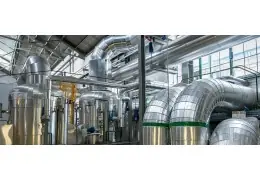Superheated water is an ideal solution for high-efficiency industrial heating, operating at temperatures up to 200°C...


What is Thermal Oil and Where is it Used?
Thermal oil (also known as heat transfer oil) is a specialized fluid used in industrial systems for transferring heat when steam or water would be inefficient or impractical. It enables safe and stable heat transfer at high temperatures without requiring the high pressures associated with steam.
Key Characteristics of Thermal Oil
-
High thermal stability: Can operate continuously at temperatures up to 300°C or more, depending on the formulation.
-
Low operating pressure: Even at high temperatures, thermal oil systems operate at low pressures.
-
Efficient heat transfer: Ensures uniform and effective thermal distribution.
-
Resistance to oxidation and thermal degradation: Modern thermal oils are formulated with additives that extend their service life and reliability.
Industrial Applications
Thermal oil is widely used in:
-
Food industry (fryers, ovens, chocolate melters)
-
Chemical processing (reactors, dryers)
-
Plastics and rubber manufacturing
-
Printing presses and roller heating
-
Bitumen and asphalt heating systems
-
Solar thermal plants (as a heat storage and transfer medium)
Advantages Over Other Heat Transfer Media
| Factor | Thermal Oil | Steam |
|---|---|---|
| Operating Temperature | Up to 300–350°C | Typically up to 180–200°C |
| Operating Pressure | Low | High |
| Corrosion Risk | Minimal | Possible on metal parts |
| Maintenance Requirements | Low | Frequent maintenance |
Maintenance and Replacement
The quality of thermal oil must be monitored regularly. Key parameters include:
-
Viscosity and flash point
-
Oxidative stability
-
Residue and decomposition by-products
Depending on usage and thermal stress, thermal oil typically needs to be replaced every 1–3 years.
Conclusion
Thermal oil is an essential medium for efficient and safe heat transfer in high-temperature industrial processes. With proper selection and maintenance, it offers long-lasting performance, lower operating costs, and reduced downtime, making it ideal for a wide range of applications.

